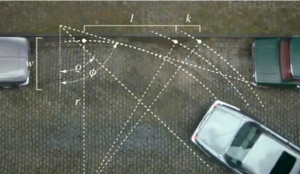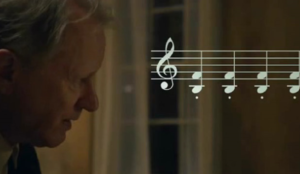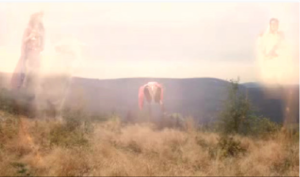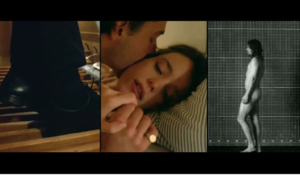Lars von Trier’s Nymphomaniac is a five hour movie in two parts that starts with a man, Seligman, finding a woman, Joe, lying in an alleyway near to his apartment. He goes to help and ends up taking her back to his apartment where she tells him the story of her life as a nymphomaniac. As she tells her story, Seligman tries to analyze what she is saying and very often links her story with some aspect of his life e.g. a book he’s read, a part of history, a painting, etc. Bizarrely, this film has an over abundance of sexually explicit scenes and yet the story is not really about sex.
At a certain point quite early on in the movie, Seligman says to Joe that he finds some of the coincidences in her story unbelievable. To which Joe replies, ‘Which way do you think you get the most of my story? By believing in it or by not believing in it?‘ And this sentence touches on von Trier’s approach to story telling; he wants the audience to know that the story is not real, the main character Joe, is not a single person and he isn’t expecting the audience to relate easily to any of the characters.
The movie has been described by many critics as Brechtian in its approach. This is a reference to the alienation effect (German Verfremdungseffekt) elaborated by the German play-write Bertolt Brecht. According to the Encyclopedia Britannica (online), this effect ‘involves the use of techniques designed to distance the audience from emotional involvement in the play through jolting reminders of the artificiality of the theatrical performance.’
Once I appreciated that von Trier wanted the audience to realize that the characters and the story were not real, many of the techniques that he used to do this became more apparent. If an audience feels alienated from a story, it is much easier for them to view it at a distance and possibly take a far more analytical or reflective approach to the messages in the film instead of simply reacting at an emotional level. This is interesting in that it is a very different approach to that of Hitchcock, who in numerous interviews claimed that making movies was all about creating an emotional response in the audience.
There are many ways that this alienation is achieved; splitting the story into clear chapters, making incidents and characters clearly unrealistic. I wanted to focus on the cinematic techniques that von Trier uses to create this alienation effect.
One of the most obvious ways of doing this is in his use of non-diegetic elements and there are many instances of it. In one of the scenes, Joe offers to park her bosses car because he is struggling to get it into a tight spot. Her boss does not believe she can do this, but lets her try anyway. The shot of her parking is taken as a birds-eye view but before she starts the manouevre, a graphic with angles and lines appears on the screen showing the mathematics. This is stark reminder to the audience that this scene is not real.

As second example of this is when Seligman is talking about music and the music he refers to starts playing as non-diegetic sound in the background, but in addition, the music appears in the frame.

A second technique von Trier uses is to create visually unrealistic shots/scenes. In one of the scenes, Joe recounts an experience she had as a child and while doing this, the audience get to see an apparent flashback of Joe being lifted up by an unseen force and hovering a few feet above the ground. The shot is in a haze and to each side of Joe, shadowy characters can be seen standing watching her. This is a send up of old fashioned science fiction/fantasy movies but it also provides a double message to the audience; the movie you are watching is not real and the story you are watching within the film, is not real either.

A third techniques is the use of a split screen to tell a story. In what I can only describe as a visually and aurally poetic scene, Seligman talks about polyphony in relation to Bach’s music. In response to this, Joe recounts her relationship with three of her lovers, likening each lover to a part of a polyphony. As she talks about each one, the screen splits into three and shows aspects of each of these lovers and the part of the polyphony that relates to them. As the sequence builds, each of the split screens has each of her lovers in it, with different shots being rotated through and all parts of the polyphony playing together. It is a beautiful sequence but at the same time it manages to show a lot of information very effectively in a short sequence. And yet again, by using this split screen, the audience is reminded that they are not watching reality but rather the portrayal of a very confused woman’s relationships.

The last aspect of the film that I would like to cover is the opening scene – simply because it is so evocative.
The opening shot is of a black screen with some unidentifiable soft sounds that eventually manifests as rain. This goes on for an uncomfortably long time, 1 minute 30 seconds to be precise – to the point that you begin to wonder if there is something wrong with the DVD. Eventually, it cuts to a shot through an outside door of a wall and a light. It is softly snowing. The location is a run-down alleyway. Nonetheless, the shot looks like a Flemish painting, and this could well be the first indication that the movie is not reality but rather a work of art. It is beautiful. It’s completely silent.
The camera cuts to close-ups of what’s going on in the alleyway; rain running down a wall, dripping onto a metal dustbin, metal parts swaying in the breeze. Eventually the camera tilts down to the ground and the audience sees, in the foreground, an arm covered in blood. However, the camera then cuts to a hole in the wall and continues its pan around the alleyway, almost as if the hand is not important. Then very suddenly, the camera cuts back to a wide shot of the alleyway and the audience sees the woman lying on the ground, clearly hurt. It is at this point that the heavy metal music of Rammstein kicks in – it’s jarring and in complete contrast to the quiet mood that had initially been established.
I’m not completely sure why the opening scene is set up this way, but my understanding of it is that von Trier first sets the audience on edge by holding onto the opening black screen, then with the arrival of the visual on the alleyway and the slow quite pan, he lulls the audience into a false sense of security. He drifts over the hand and moves on – imply that it is not significant – and then suddenly changes his mind – it is very significant – so jump cuts to the wide alleyway shot and blasts the scene with heavy music. Possible trying to jolt the audience out of their security. This is one of my favourite scenes in the movie; both complex and simple at the same time.
Bibliography:
Nymphomaniac Vol 1. Director’s Cut. [feature film, DVD] Dir. Lars von Trier. Zentropa Entertainments, Denmark, 2013. 145 min
Nymphomaniac Vol 2. Director’s Cut. [feature film, DVD] Dir. Lars von Trier. Zentropa Entertainments, Denmark, 2013. 180 min
Encyclopedia Britannica [online], at http://www.britannica.com/art/alienation-effect (Accessed on 17/06/2016)
